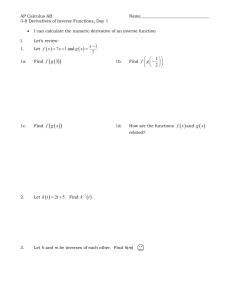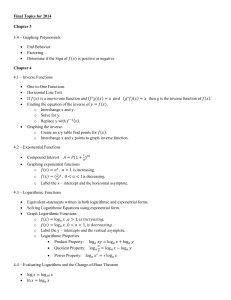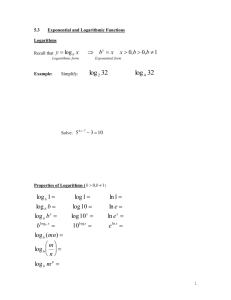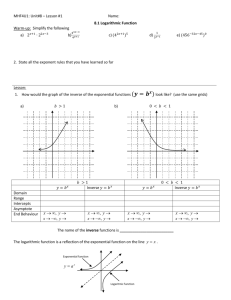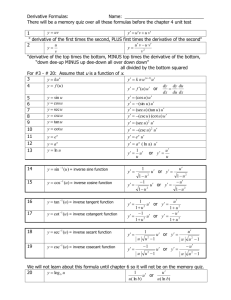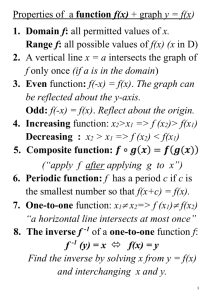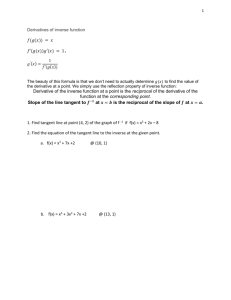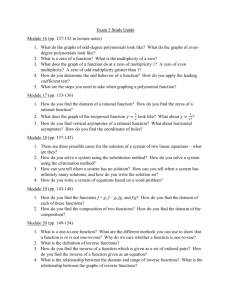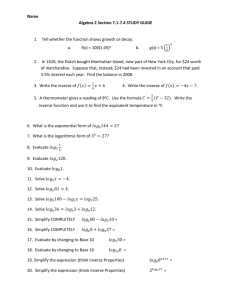5-1 The Natural Logarithmic Function and Differentiation
advertisement
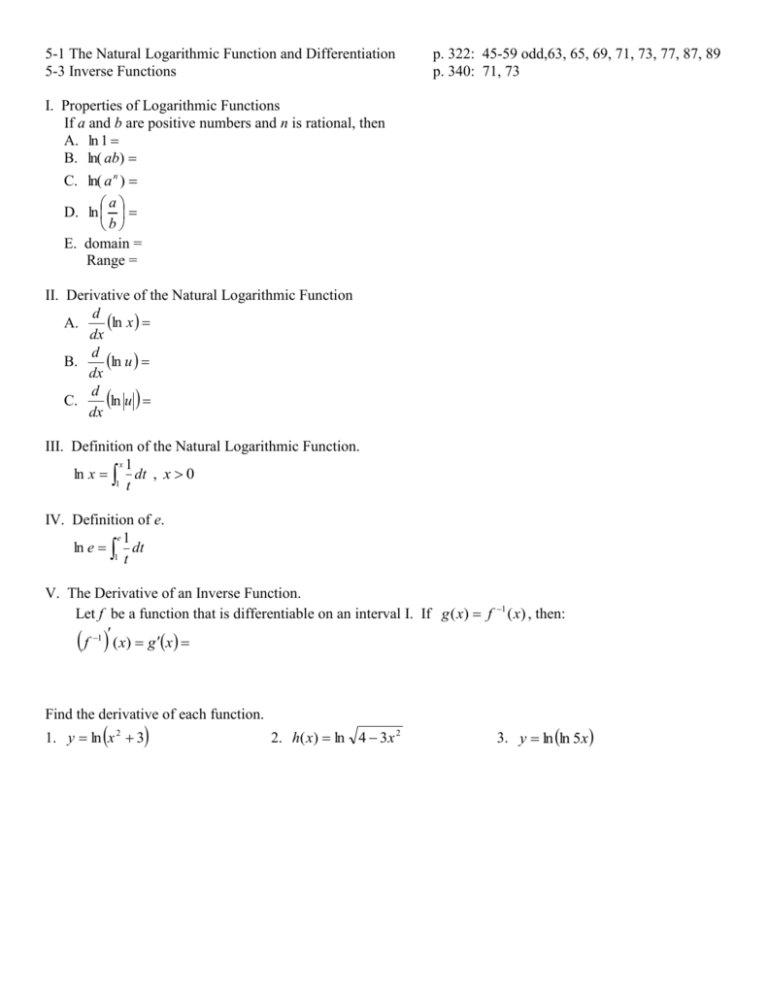
5-1 The Natural Logarithmic Function and Differentiation 5-3 Inverse Functions p. 322: 45-59 odd,63, 65, 69, 71, 73, 77, 87, 89 p. 340: 71, 73 I. Properties of Logarithmic Functions If a and b are positive numbers and n is rational, then A. ln 1 B. ln( ab) C. ln( a n ) a D. ln b E. domain = Range = II. Derivative of the Natural Logarithmic Function d ln x A. dx d ln u B. dx d ln u C. dx III. Definition of the Natural Logarithmic Function. x1 ln x dt , x 0 1 t IV. Definition of e. e1 ln e dt 1 t V. The Derivative of an Inverse Function. Let f be a function that is differentiable on an interval I. If g ( x) f f 1 ( x) g x 1 ( x) , then: Find the derivative of each function. 1. y ln x 2 3 2. h( x) ln 4 3x 2 3. y ln ln 5x 4. x2 4 2 6 x 5 g x ln 5. y ln(sin 3 x) 6. Find an equation of the tangent line to the graph of y x 2 ln 4 x 7 at the point (2,4). 7. Find y by using implicit differentiation. x y 2 ln 4 x 3 y dy by using logarithmic differentiation. dx 2 3 y x 1 x 2 8. Find a 9. Find f 1 for the function f and real number a. f x 2 x x 3 , a 8 5-2 The Natural Logarithmic Function and Integration. p. 330: 1-13 odd, 19-23 odd, 27-43 odd, 61-64 all, 67, 69, 77, 79, 81 I. Logarithmic Rule for Integration Let u be a differentiable function of x. 1 A. dx x 1 B. du u II. Integrals of the Six Basic Trig Functions A. sin udu B. C. D. E. F. cos udu tan udu cot udu sec udu csc udu Find each indefinite integral. 3x 2 1 dx 1. 3 2x 2x 5 1 dx 4. sin 3 x 2. 1 x ln x dx sin 2 x dx 5. cos x 3. x 32 dx x x 2 5x 6 dx 6. x 1 7. Solve the differential equation. dy 5 ; 2,0 dx 5 x 8. Find the area of the region bounded by the graphs of each equation. y 2 tan x , y 0 , x 0 , x 4 9. Find 10. Find the average value of the function over the given interval. ; 5-4 Exponential Functions: Differentiation and Integration p. 347: 37-61 odd, 78b, 87-111 odd, 113b, 115 I. The Natural Exponential Function A. y e x is the inverse of y ln x B. Domain of y e x is , , Range is 0, C. It is continuous, increasing, concave up on its entire domain. D. lim e x and lim e x x x II. The derivative of the Natural Exponential Function d x e A. dx d u e B. dx III. Integration Rules of Exponential Functions A. e x dx B. e u du 1. Find an equation of the tangent line to the graph of y xe Find the derivative of each. 2. f x e 5 x ln x 3. y ln sin e x 1 x3 ln 2 x 2 at the point 1, e 4. e xy x 2 y 2 0 Evaluate each integral 5. 6 3 ex dx e3x 7. cot e 2 x e 2 x dx 5-5 Bases Other than e p. 357: 41-67 odd I. Definition of Exponential Function to Base a If a is a positive real number, then a x e x ln a II. Properties of Exponential and Logarithmic Functions to Base a A. a 0 B. a x a y ax C. y a y D. a x E. a loga x F. log a a x G. log a x III. Derivatives for Bases Other than e d x a A. dx d u a B. dx d log a x C. dx d log a u D. dx IV. Integration for Bases Other than e A. B. Find the derivative of each function. 1. f x 5 x 2. g x 12 3 x 3 2 3. y log 3 2x 5 3x 8 5. y 2 x 1 4. y x 3 3 x Evaluate each indefinite integral. 6. x 2 dx 7. 2 x 4x 5 dx 3 x 8. 7x 7 x 4 dx 5-6 Differential Equations: Growth and Decay p. 366: 1-9 odd, 15, 17, 25 5-6 Worksheet: 1, 4, 7, 10 I. Separable Differential Equations dy ky dt II. Exponential Growth and Decay If y is a differentiable function of t such that y > 0 and y ky for some constant k, then y Ce kt y= C= t= k= III. Newton’s Law of Cooling d k y c dt y e kt e b c y= C= k = Solve the differential equation. 12 x 1. y y 2. 5 x 3 y 3x 2 y 0 3. A bacteria culture starts with 500 bacteria and after 3 hours there are 8000 bacteria. Find an expression for the number of bacteria after t hours. Find the number of bacteria after 4 hours. When will the population reach 30,000? 4. Polonium-210 has a half life of 140 days. If a sample has a mass of 200mg, find a formula for the mass that remains after t days. Find the mass after 100 days. 5. An object takes 30 minutes to cool from 125 F to 100 F when placed in a room kept 75 F. What will be its temperature at the end of 1 hour of cooling? When will its temperature be 80 F? 5-8 Inverse Trigonometric Functions and Differentiation p. 386: 41-51 odd, 56 Differentiation Review Worksheet I. Inverse Trigonometric Functions - y 2 2 1 B. y cos x iff cos y x for 1 x 1 and 0 y - C. y tan 1 x iff tan y x for x and y 2 2 1 D. y cot x iff cot y x for x and 0 y A. y sin 1 x iff sin y x for 1 x 1 and E. y sec 1 x iff sec y x for x 1 and 0 y , y F. y csc 1 x iff csc y x for x 1 and 2 - y y0 2 2 II. Derivatives of Inverse Trigonometric Functions Let u be a differentiable function of x. d d arcsin u arccos u A. D. dx dx d d arctan u arc cot u B. E. dx dx d d arc sec u arc csc u C. F. dx dx Find the derivative of the function. 1. 4. 2. 3. 5. 6. Evaluate the limit as a derivative of a function at the indicated value. 2 2 32 h 32 lim h 0 h 5-9 Inverse Trigonometric Functions and Integration p. 393: 1-27 odd, 31-41 odd, 47, 49, 51b, 55 I. Integrals of Inverse Trigonometric Functions. Let u be a differentiable function of x and let a>0. du 1. 2 a u2 du 2. 2 a u2 du 3. u u2 a2 II. Integration Tips for Quotients A. Make the integrand conform to the power rule B. Let the entire denominator represent the u for 1 u du ln u c C. Divide improper quotients D. Apply Inverse Trig Integration rules. Evaluate the integral. 1 dx 1. 4 25 x 2 4. . x x 2 36 dx 2. x 1 9x 2 1 5. dx ex 49 e 2 x 3. dx x5 x 4 1dx 6. x 2 7. x 2 8. dx 4x 9 2x dx 8 x 20 1 x 2 6x dx
